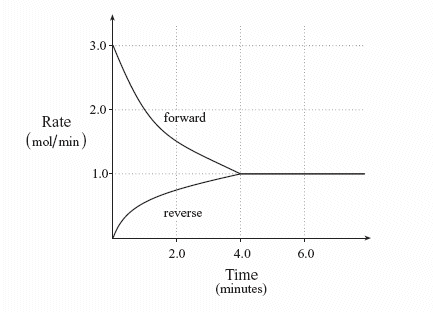1.2 Equilibrium
Here's another example of a reversible reaction - dissolving salt in
a beaker of water, described by the following reaction:
NaCl(s)  NaCl(aq)
NaCl(aq)
If you keep adding more and more solid salt, eventually you'll reach the point where no more salt dissolves, and the excess sits at the bottom of the beaker. At this point we have a saturated solution. Has the dissolving reaction stopped? It would appear so, but that's not the case (wouldn't that be too easy?).
What happens in our saturated solution, which has reached the point of equilibrium, is that both the forward
NaCl(s) → NaCl(aq)
and reverse
NaCl(aq) → NaCl(s)
reactions are still going on, but at the same rate. This in effect cancels out any observable, or measurable, changes in our system. At the same rate that solid NaCl produces aqueous NaCl (dissolved salt), the dissolved salt is recrystallizing to form more solid NaCl.
Equilibrium is the state at which the rate of the forward reaction equals the rate of the reverse reaction.
At the point of equilibrium, no more measurable or observable changes in the system can be noted. |
It is important for you to understand that equilibrium means the rates of the forward and reverse reactions are equal; it does not mean that there are equal amount of reactants and products present at equilibrium.
For example, the following reaction was allowed to come to the point of equilibrium, and concentrations of all reaction participants were measured at that time:
H2 (g) + I2 (g)  2 HI(g)
2 HI(g)
| At equilibrium: |
[H2] = 0.022 M
[I2] = 0.022 M
[HI] = 0.156 M |
For this particular reversible reaction, there is more HI at equilibrium (0.156 M) than there is of H2 and I2 (both at 0.022M).
We say the product side of the reaction is favoured.
Equilibrium does not mean equal amounts at equilibrium!
Here's something to help you understand about how equilibrium works. Imagine yourself on a escalator that is going down. You start at the top (reactants) and end up at the bottom (products). But when you are partway down you start walking up the escalator as it continues going down. If you match your rate of walking up to the same rate that the escalator is going down, you make no progress and appear to be at a standstill. To an observer it would look as if you and the escalator had come to a stop, but actually both upward and downward movements continue.
Equilibrium is dynamic - both forward and reverse reactions continue, even though the reaction appears to have stopped. And this equilibrium does not need to occur right in the middle of two floors - you could be near the bottom, near the top, or anywhere in between when you carry out your reverse process.
In order for a reversible reaction to reach the point of equilibrium, the reaction must be carried out in a closed system - no additional reactants can be added or products removed. If, in our last example, the product HI was removed as it formed, the reaction would never reach the point of equilibrium - instead H2 and I2 would continue to react to produce HI until one or both of the reactants was used up.
If reactants are constantly being added, and products removed as they form, the system would appear to be at equilibrium because to an outside observer it would appear that the reaction has stopped, but that would not be the case. This situation - with new material constantly being added as products are removed - is called a steady state system. A factory with an assembly line is a steady state system - new raw materials are constantly being added; finished products are removed. A campfire with wood being added to the fire is another steady state system. Be careful not to confuse steady state with equilibrium.
How do the rates of the forward and reverse reactions as the reaction heads towards equilibrium (before it reaches equilibrium?)
If we start our above reaction with H2 and I2, and with no HI, the two gases will react at a certain rate. But remember that the rate of a reaction slows down over time, as the reactants get used up (and lower their concentration). Eventually, however, the amount of the product HI increases, and it will begin producing H2 and I2. Thus the rate of the reverse reaction starts out slowly (there is no HI present), but will speed up as the concentration of HI increases. Eventually both rates will level off (not always to the same level as shown by this example, however):

NaCl(aq)


